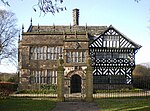Astley Bridge Mill
Cotton millsGrade II listed buildings in the Metropolitan Borough of BoltonGrade II listed industrial buildingsTextile mills in the Metropolitan Borough of Bolton

Astley Bridge Mill or Holden Mill is a former cotton mill in the district of Astley Bridge in Bolton, Greater Manchester, England which has since been converted into an apartment building. Constructed in 1926 for Sir John Holden & Sons Ltd, it was the last cotton mill to be built in Bolton and is a Grade II listed building.
Excerpt from the Wikipedia article Astley Bridge Mill (License: CC BY-SA 3.0, Authors, Images).Astley Bridge Mill
Hill Cot Road,
Geographical coordinates (GPS) Address Nearby Places Show on map
Geographical coordinates (GPS)
| Latitude | Longitude |
|---|---|
| N 53.6052 ° | E -2.4313 ° |
Address
Hill Cot Road
Hill Cot Road
BL1 8RL , Astley Bridge
England, United Kingdom
Open on Google Maps



